2. 黑龙江省第四地质勘查院, 哈尔滨 150036;
3. 云南澜沧铅矿有限公司, 澜沧 665601
2. Fourth Geological Exploration Institute of Heilongjiang Province, Harbin 150036, China;
3. Yunnan Lancang Lead Mine Limited Company, Lancang 665601, China
老厂Pb-Zn多金属块状硫化物矿床位于西南三江特提斯造山带南部昌宁-孟连缝合带内,多项证据证实石炭纪发生过大规模火山喷流沉积作用成因(VMS型)Pb-Zn成矿作用,并部分受到新生代岩浆热液活动的复合(叶庆同等,1992;杨开辉和莫宣学, 1993a, b;丁林和钟大赉,1995;李雷等,1996;龙汉生等,2009;罗思亮等,2010;龙汉生等,2011;杨立强等,2011;邓军等,2012;叶霖等,2012;Li et al., 2015;Deng et al., 2017)。VMS型成矿作用的证据包括:火山岩容矿型层状矿体,“上层下脉”矿体双层结构和“上黑下黄”的矿化分带,纹层状富硫化物碳硅质岩(喷气岩)发育等(杨开辉和莫宣学, 1993a)。Liu et al. (2015)对老厂块状矿体中方铅矿和闪锌矿进行直接的Re-Os定年,获得的等时线年龄为~308Ma,该年龄与容矿火山岩的锆石U-Pb年龄~320Ma(陈觅等,2010)基本一致,从而证实了同火山期Pb-Zn成矿作用的存在。陈觅等(2011)和Li et al. (2015)对老厂矿床早石炭世容矿火山岩全岩元素组成和Nd-Pb同位素组成进行系统研究,结果显示其具有典型的洋岛玄武岩(OIB)地球化学特征。与OIB火山岩有关的VMS型矿床全球罕见,但单个矿床规模巨大,目前已知的仅有加拿大Windy Craggy巨型Cu-Co-Au矿床(Peter et al., 2014)。老厂块状硫化物金属资源量巨大,截至2010年,已揭示平均品位4.5%的Pb金属量86.58万吨、3.3%的Zn 33.55万吨、155g/t的Ag 1736.84吨、0.5%~0.9%的Cu 11.61万吨、硫铁矿283.61万吨及伴生Au 805千克(李光斗,2010)。最近老厂矿床又发现了新的厚大Pb-Zn块状硫化物矿体,进一步证实了与OIB火山岩相关的VMS成矿具有显著的金属集聚能力和良好的成矿潜力。因此,老厂矿床为深入理解该特殊成因类型的VMS型矿床的成矿作用过程提供了良好窗口。
从20世纪60年代被发现至今,VMS矿床始终是矿床地质学界的研究热点(Lydon, 1984; Humphris et al., 1995; Franklin et al., 2005;Galley et al., 2007)。作为一类重要的热液型矿床,其成矿流体性质和成矿物质来源是制约矿床成矿作用过程的基本要素(Ohmoto and Skinner, 1983; Hou et al., 2001)。对现代和地史时期中VMS矿床成矿流体进行系统研究表明,其通常表现为一种中低温-高温(100~400℃)、富含金属成矿元素(Fe、Cu、Zn、Pb和Ba等)的还原性流体(Campbell et al., 1988; Lydon, 1988; Large, 1992; 侯增谦等,1999),来源主要包括海水(Frankin, 1981; Lydon, 1988)和岩浆水(Yang and Scott, 1996, 2002)。老厂矿床目前报导的成矿流体研究数据仅少量见于20世纪90年代或之前的文献中,受制于当时测试手段、仪器的落后性与样品采集的非系统性等因素,数据结果差异较大,缺乏科学说服力,因此新的系统研究工作有必要进行。VMS型矿床硫同位素组成研究可以提供成矿热液体系中硫元素的来源、运移和沉淀机制等信息。通常认为,VMS型矿床硫有三种来源,包括与岩浆作用相关的幔源硫、海相硫酸盐通过无机还原和有机还原(细菌还原)作用形成的硫(Rye and Ohmoto, 1974; Ohmoto, 1986)。本文在对老厂VMS矿床野外观察和矿相学基础上,开展了流体包裹体显微测温和硫同位素组成分析,籍以对成矿流体演化和矿石硫同位素来源进行制约;结合前人地球化学数据,进一步探讨了矿床成矿环境和成矿过程。
2 地质概况 2.1 区域地质背景昌宁-孟连缝合带位于西南三江特提斯成矿带南部,介于东侧思茅地块和西侧保山地块之间(沈上越等,2002;邓军等, 2011, 2013, 2014, 2016;Wang et al., 2014; Zhang et al., 2014; Deng and Wang, 2015),北端被崇山剪切带截切,向南穿越缅甸并延伸到泰国北部(Wu et al., 1995; Metcalfe, 2011),为一条长约200km、宽约5~30km的近南北向延伸的狭长条带(图 1),其内发育蛇绿混杂岩、火山岩、变质岩、浅海相碳酸盐岩和远洋沉积岩(富含硅质岩)等(Shi and Archbold, 1998; Klaus et al., 2007; Sone and Metcalfe, 2008)。区域内由老至新主要出露元古代、古生代、中生代和新生代地层,其中古生代主要出露泥盆系、石炭系和二叠系地层。
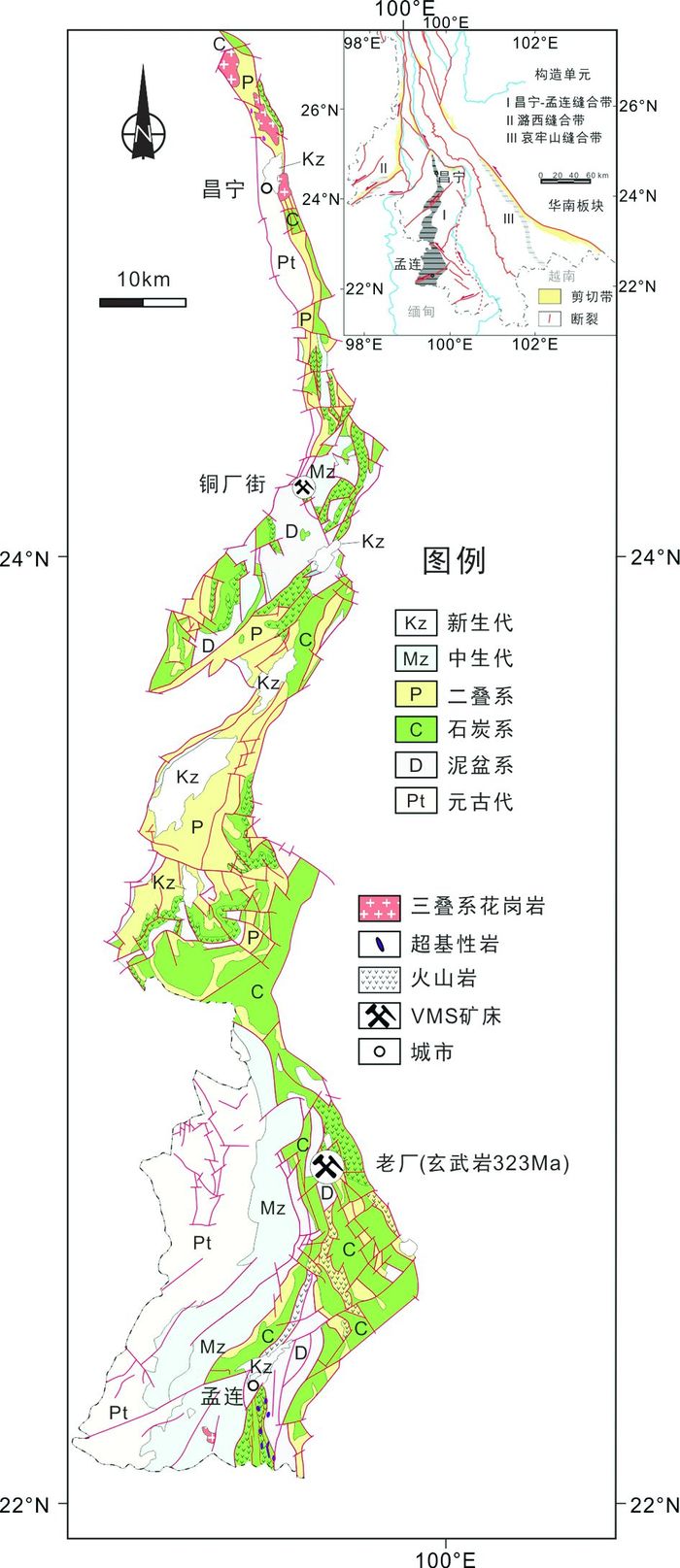
|
图 1 昌宁-孟连缝合带区域地质图(据Burchfiel and Chen, 2013; Li et al., 2015修改) Fig. 1 Geological map of Changning-Menglian suture zone (modified after Burchfiel and Chen, 2013; Li et al., 2015) |
缝合带内OIB火山岩发育广泛,Feng(2002)认为部分火山岩系OIB成因,时代跨越晚泥盆世至晚二叠世。Fang and Niu(2003)对缝合带南部孟连地区枕状苦橄岩橄榄石斑晶进行电子探针分析,由橄榄石斑晶成分(Fo=0.902±0.011) 计算出母岩浆MgO含量高达17%~19%,基此进一步计算出母岩浆温度在1400±25℃,从而认为其系地幔柱热幔成因。赖绍聪等(2010)基于全岩元素组成研究,提出缝合带北部乌木龙-铜厂街地区碱性玄武岩属于OIB型。
Metcalfe (2011)和Deng et al.(2014a, b)综合研究认为昌宁-孟连古特提斯洋开启于中泥盆世(~400Ma),继而持续扩张成为古特提斯主洋;洋板片东向俯冲伊始于早二叠世(~290Ma),最终闭合于中三叠世(~235Ma),随后于新生代(~45Ma)发生构造破碎。古地磁数据显示保山地块和思茅地块在晚石炭世古纬度相差最大,反映了该时期开阔的大洋环境(Li et al., 2004)。昌宁-孟连缝合带VMS成矿作用突出,目前揭示出两个主要的VMS矿床,即北部铜厂街Cu多金属矿床和南部老厂Pb-Zn多金属矿床。区内广泛发育与已知VMS型矿床容矿火山岩形成时代一致且地球化学特征类似的火山岩,最近的找矿工作在这些火山岩中也发现了一些矿化异常现象,反映该区可能存在着较大的VMS型矿床找矿潜力。
2.2 矿床地质特征老厂VMS型Pb-Zn多金属矿床地处昌宁-孟连构造-成矿带南部,系该带内规模最大、经济价值最高的矿床。老厂矿床主要出露泥盆纪、石炭纪、二叠纪及第四纪地层(图 2),其中泥盆系为一套碎屑岩夹硅质岩建造,以飞来峰形式零星产出于矿床北部。下石炭统(即依柳组C1y)火山-沉积序列总厚度达870m,从底部到顶部共分为3个火山旋回和8个岩性层,由中基性火山岩及火山碎屑岩组成,火山岩主要为玄武岩、安山岩和粗面岩等,火山碎屑岩主要为玄武质、玄武安山质、安山质、粗面质凝灰岩(图 3h)、角砾岩(图 3g)和集块岩等(冯庆来和刘本培,1993),该层位控制了大部分硫化物矿体的产出(陈百友,2002)。上石炭统-下二叠统为一套连续沉积的碳酸盐建造,主要岩性为灰岩和白云质灰岩。矿区内构造较为复杂,褶皱主要是老厂背斜和睡狮山向斜,其中尤以老厂背斜形态复杂且为矿区内主要控矿构造。断层走向主要为SN向和NW向,NE向断层次之;SN向和NW向断层控制了老厂中心式火山喷发,硫化物矿体常围绕火山喷发中心沉积洼地分布(龙汉生等,2011)。区内发育推覆构造,是澜沧-孟连西部逆冲推覆构造系的组成部分(梁坤,2014)。
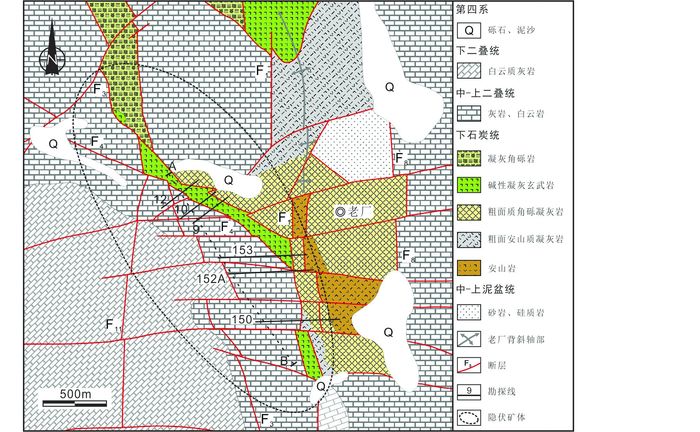
|
图 2 老厂矿区地质图(据龙汉生等,2009修改) Fig. 2 Geological map of Laochang ore deposit(modified after Long et al., 2009) |
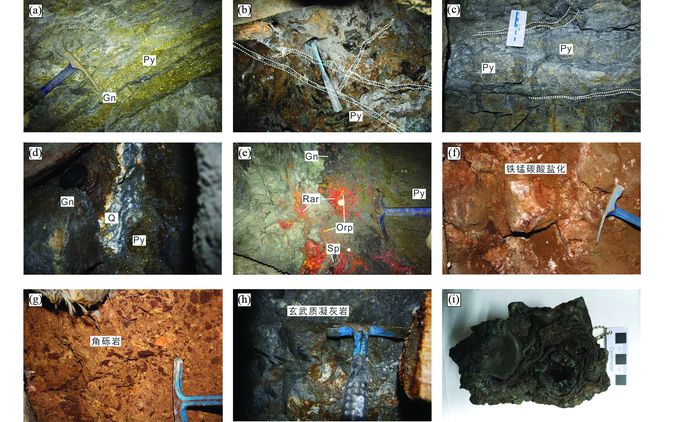
|
图 3 老厂矿床地质特征 (a)似层状矿体;(b)网脉状矿化;(c)浸染状矿化;(d)块状矿体中含石英;(e)块状矿体顶板,含雄黄;(f)铁锰碳酸盐化;(g)角砾岩;(h)玄武质凝灰岩;(i)古人炼银炉渣.Py-黄铁矿; Ccp-黄铜矿; Gn-方铅矿; Sp-闪锌矿; Rar-雄黄; Orp-雌黄; Q-石英 Fig. 3 Photographs showing the geological characteristics of Laochang ore deposit (a) stratiform-like orebody; (b) stockworks mineralization; (c) disseminated mineralization; (d) massive ore with quartz; (e) roof of massive orebody with realgar; (f) Fe-Mn carbonatation; (g) breccia; (h) basaltic tuff; (i) the ancients silver smelting slag. Py-pyrite; Ccp-chalcopyrite; Gn-galena; Sp-sphalerite; Rar-realgar; Orp-orpiment; Q-quartz |
老厂矿床产出原生和次生两种矿体。原生矿体主要为产于下石炭统(C1y)火山岩和中上石炭统(C2+3)、下二叠统(P1)碳酸盐中的硫化矿、氧化矿及混合矿;原生矿体在垂向上分成三个矿群,主要矿群(Ⅰ号和Ⅱ号矿群)分别形成于第二和第三火山喷发旋回末期。各矿群内块状硫化物矿体逐次向上堆叠,其垂直投影基本一致,说明在整个矿化过程中喷流系统基本固定并且持续活动。次生矿体主要是残积、冲积和洪积形成的泥铅、砂铅、人工堆积的废矿石堆以及古人炼银留下的高铅炉渣(图 3i),累积探明金属储量为Ag 1600吨,(Pb+Zn)120万吨(龙汉生等,2011)。
矿床中原生矿体的矿化分带明显,无论是单个矿体还是整个矿体群,均表现出“上黑(方铅矿-闪锌矿)下黄(黄铁矿-黄铜矿)”的分带结构。相应的金属元素从下至上显示出Fe-Cu、Cu-Zn-Pb到Pb-Zn-Ag的变化规律,围岩蚀变也具有黄铁绢英岩化-黄铁矿化-青磐岩化-铁锰碳酸盐化(图 3f)的变化规律(李雷等,1996)。在块状矿体下盘或其附近是与其同期成矿作用形成的网脉状或浸染状矿化,表现出典型的“上层下脉”的VMS型“双层结构”特征。主要硫化物矿物包括黄铁矿、方铅矿、闪锌矿和黄铜矿(图 4a-c),其次为磁黄铁矿、毒砂、黝铜矿、砷黝铜矿、斑铜矿、雄黄(图 3e)、雌黄、白铁矿和辉银矿等。脉石矿物包括石英(图 4e)、方解石、白云石、透长石、斜长石、绢云母和绿泥石等(李峰等,2009)。硫化物矿石主要有块状构造(图 4a, d)、层状构造(图 4f)、条带状构造、浸染状构造(图 3c)和角砾状构造(图 4c)等。矿石结构复杂多样,有交代溶蚀结构、交代残余结构、固溶体分离结构(图 4g)和胶状结构(图 4i)等。近年来,随着危机矿山项目的开展,老厂矿床又发现了新的厚大块状矿体群(编号Ⅳ),为VMS成矿进一步的研究工作提供了新的对象。
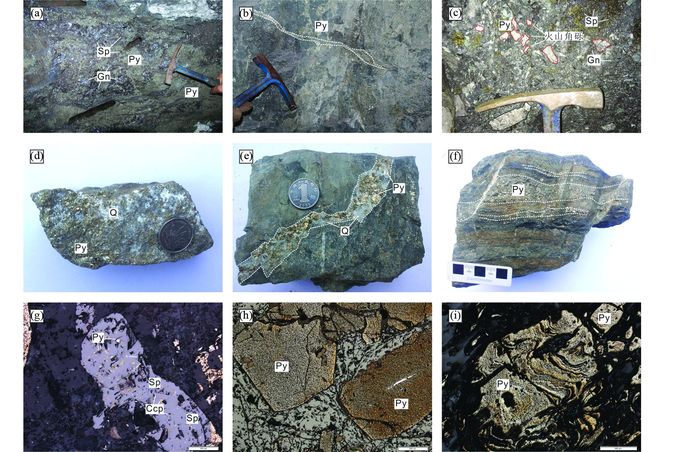
|
图 4 老厂矿床矿石组构图 野外照片:(a)块状矿体;(b)网脉状矿化;(c)火山角砾被硫化物胶结;手标本照片:(d)块状矿石;(e)网脉状矿石;(f)纹层状矿石;显微照片:(g)固溶体分离结构闪锌矿(反射单偏光);(h)自形晶黄铁矿(反射单偏光);(i)胶状黄铁矿(反射单偏光) Fig. 4 Photographs showing the ore texture of Laochang deposit Field photographs: (a) massive orebody; (b) stockworks mineralization; (c) volcanic breccia cemented by sulfide ore; Specimen photographs: (d) massive ore; (e) stockworks ore; (f) lamellar ore; micrographs: (g) exsolution sphalerite (-); (h) self-shape pyrite (-); (i) colloform pyrite (-) |
本次研究的测试样品均采自Ⅰ号矿体群的原生硫化物矿体,所采集样品及附近围岩未见与下部花岗斑岩有关的硅化-钾化和矽卡岩化蚀变,因此认为样品未受下部花岗斑岩改造。在矿相学观察基础上,对样品依次开展了流体包裹体显微测温实验(共6件)和硫化物矿石硫同位素测试(共6件)。在老厂VMS矿床进行成矿流体研究过程中,参考国内外研究者对VMS矿床成矿流体的研究方法(Ohmoto and Rye, 1974; Marutani and Takenouchi, 1978; 侯增谦等,2003;Chen et al., 2015),将老厂矿床成矿过程分为两个成矿阶段,分别是网脉状矿化阶段和块状矿体成矿阶段;因此,选取块状矿体和其下部网脉状矿化中透明矿物(石英和方解石)进行流体包裹体显微测温实验。硫同位素测试对象是网脉状、浸染状和块状硫化物单矿物。具体采样位置见图 5。
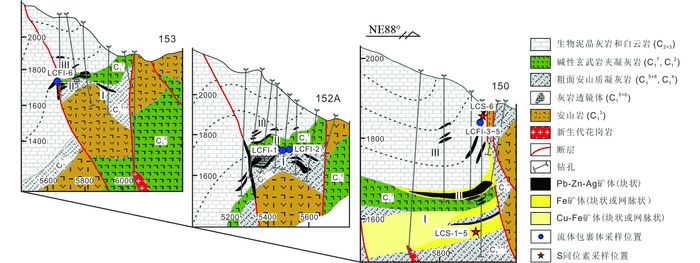
|
图 5 老厂矿床剖面及采样位置图(据杨开辉和莫宣学,1993a; Li et al., 2015修改) Fig. 5 Diagram of profile and sample locations in Laochang ore deposit(modified after Yang and Mo, 1993a; Li et al., 2015) |
在样品清洗处理后,将块状矿体和网脉状矿化透明矿物样品磨制成厚度0.3mm双面抛光的流体包裹体片。利用光学显微镜对其进行流体包裹体岩相学特征观察,随后对有实验价值的流体包裹体片使用丙酮浸泡48h,使之与载玻片充分分离并用无水乙醇擦洗干净后晾干。显微测温实验是在中国地质大学(北京)流体包裹体实验室完成,使用Nikon LV100NPOL型显微镜进行观测;测温仪器使用的是英国生产的LINKAM THMSG600冷热台,其测温范围是-196~600℃,在-120~-70℃温度区间内的测试精度为±0.5℃,在-70~+100℃区间内精度为±0.2℃,在+100~+500℃区间内精度为±2℃。测温软件为Linksys。冷冻测温时,利用液氮进行降温;包裹体冷冻后缓慢升温,接近相变温度时,控制升温速率,速度为0.5℃/min,以准确记录冰点温度。均一测温时,控制升温速率在20℃/min,温度上限为400℃。
对硫同位素样品进行粉碎过60目筛子筛选,随后在双目镜下进行单矿物挑选,挑选出黄铁矿、方铅矿和闪锌矿单矿物各1g,纯度达到99%。实验测试是在中国地质大学(北京)地质过程与矿产资源国家重点实验室完成,使用DZ/T 0184.14—1997方法完成,所用仪器为EA-ISOPRIME100,使用标样为GBW04414、GBW04415,环境条件为氧化炉温度1150℃,还原炉温度850℃,测试精度≤0.15‰。
4 分析结果 4.1 流体包裹体岩相学老厂矿床发育与网脉状矿石和块状矿石同期的透明矿物,为研究老厂矿床成矿流体特征提供了有利条件。在光学显微镜下观测到老厂矿床包裹体个体大小较小,长轴长度以3~8μm为主,极个别可达20μm(图 6)。基本上呈零星分布,个数较少,未见呈线状分布的包裹体,根据Roedder(1976, 1984)和卢焕章等(2004)的划分方法,将这些包裹体认定为原生包裹体。包裹体边界清晰,形态多样,如椭圆形、多边形、圆形和不规则形,未见子矿物、CO2包裹体和沸腾包裹体。根据室温下流体包裹体中各相成分和比例之间关系,将老厂矿床原生流体包裹体划分为2种类型:
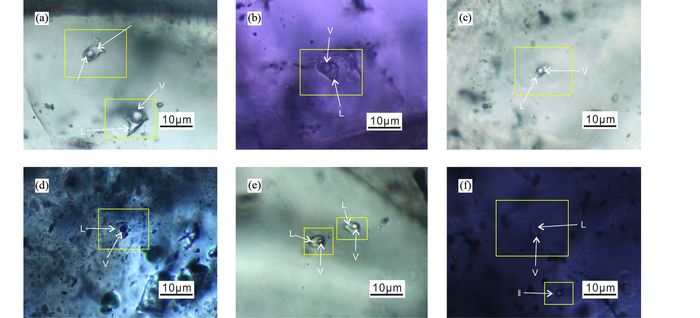
|
图 6 老厂矿床流体包裹体特征图 V-气相;L-液相;Ⅱ-类型Ⅱ Fig. 6 Micograph of fluid inclusions features in Laochang ore deposit V-vapor phase; L-liquid phase; Ⅱ-type Ⅱ |
类型Ⅰ:气-液两相包裹体。该类型广泛出现在老厂矿床透明矿物中,也是VMS矿床的主要包裹体类型(Ohmoto and Rye, 1974; Wilson and Petersen, 1989; Hou and Zhang, 1998)。可以根据流体包裹体中气-液两相比例分为富液相包裹体Ⅰa(图 6b-e)和富气相包裹体Ⅰb(图 6a)。其中富液相包裹体数量较多,长轴长度一般在3~10μm为主,颜色一般较浅或者几乎无色,多为椭圆状、多边形和不规则状,气相占包裹体体积多为10~30%;富气相包裹体数量较少,但个体相对较大,长轴一般在6~12μm为主,颜色相对较深,多为不规则状,气相占包裹体体积可达80%。
类型Ⅱ:单相包裹体。又可分为纯液相包裹体Ⅱa(图 6f)和纯气相包裹体Ⅱb。这类包裹体在老厂矿床中较为少见,个体也较小,孤立分布。
4.2 流体包裹体显微测温老厂矿床矿石中透明矿物流体包裹体个体较小且数量较少,导致测试难度较大,共计测试流体包裹体数量为107个,其中网脉状矿化测试87个,块状矿体测试20个。盐度值根据Bodnar(1993)中NaCl-H2O型包裹体盐度计算公式求得,密度值则利用经验公式求得(刘斌和沈坤,1999)。
均一法测温结果显示,块状矿体方解石中包裹体均一温度为110~158℃,平均温度为131℃;网脉状矿化石英中包裹体均一温度为186~371℃,集中于246~339℃,平均温度为291℃(表 1)。
|
|
表 1 老厂矿床流体包裹体显微测试结果 Table 1 Thermometry of fluid inclusions in Laochang ore deposit |
冷冻法测温结果显示,块状矿体方解石中包裹体冰点温度为-9~-15℃,平均温度为-12℃;对应盐度范围为13.2%~18.7% NaCleqv,平均盐度为16.1% NaCleqv。网脉状矿化石英中包裹体冰点温度为-2~-17℃,平均温度为-8℃;对应盐度范围为3.6%~19.8% NaCleqv,集中于6.9%~16.8% NaCleqv,平均盐度为10.8% NaCleqv(表 1)。测试结果与李虎杰和田煦(1995)对老厂矿床硫化物矿体流体包裹体显微测试结果基本一致(均一温度为160~350℃,盐度为4.6%~17.0% NaCleqv)。
根据实验的测温数据和计算出的盐度数据,可对包裹体密度进行计算,结果显示网脉状矿化成矿流体密度为0.675~0.960g/cm3,平均为0.836g/cm3;块状矿体成矿流体密度为1.029~1.073g/cm3,平均为1.051g/cm3(表 1)。
4.3 硫同位素组成本次研究主要对采集于老厂矿床Ⅰ1+2号矿体中的硫化物单矿物进行硫同位素测试,其中黄铁矿4件,方铅矿1件,闪锌矿1件,而网脉状矿化和浸染状矿化采集于对应的块状矿体之下。
数据结果显示,老厂矿床Ⅰ1+2号矿体群硫化物δ34S范围较窄(表 2),为-0.69‰~1.32‰,极差仅为2.01‰,平均值为0.73‰,呈集中于零值的分布特征。其中黄铁矿δ34S范围为0.67‰~1.28‰(n=4),极差为0.61‰,平均值为0.93‰;闪锌矿δ34S为1.32‰(n=1);方铅矿δ34S为-0.69‰(n=1)。如果按矿石构造类型分类,块状矿体δ34S值为0.67‰(n=1);网脉状矿化δ34S值为-0.69‰~1.32‰(n=3),极差为2.01‰,平均值为0.63‰;浸染状矿体δ34S值为0.78‰~1.00‰(n=2),极差为0.22‰,平均值为0.89‰。
|
|
表 2 老厂矿床硫化物矿石硫同位素数据 Table 2 Sulfur isotope of sulfide ore in Laochang ore deposit |
老厂矿床透明矿物中流体包裹体显微测温结果显示出一定的规律性。下部网脉状矿化成矿流体温度相对较高(186~371℃,平均为291℃)(图 7c),上部块状矿体成矿流体温度(110~158℃,平均为131℃)相对较低(图 7a)。老厂矿床块状硫化物矿体是通过海底硫化物堆积作用形成的(Li et al., 2015),从网脉状矿化到块状矿体的成矿温度降低(图 7),反映较高温度的成矿热液沿喷流通道上升至海底面与海水作用并降温。而网脉状矿化成矿流体温度范围变化较大,推测由上述过程中高温成矿流体与通道围岩发生热交换或与进入通道内的海水发生混合所导致。
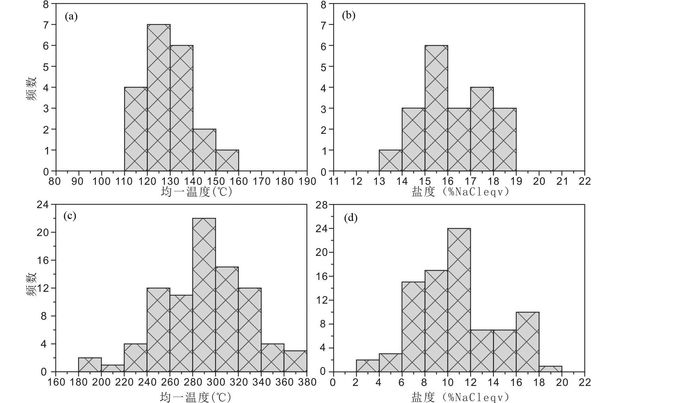
|
图 7 老厂矿床块状矿体和网脉状矿化均一温度和盐度直方图 块状矿体均一温度直方图(a)和盐度直方图(b);网脉状矿化均一温度直方图(c)和盐度直方图(d) Fig. 7 Histogram of fluid inclusions homogenization temperature and salinity in Laochang ore deposit Histogram of fluid inclusions homogenization temperature (a) and histogram of fluid inclusions salinity (b) in massive orebody; histogram of fluid inclusions homogenization temperature (c) and histogram of fluid inclusions salinity (d) in stockworks mineralization |
网脉状矿化成矿流体盐度为3.6%~19.8% NaCleqv(图 7d),平均为10.8% NaCleqv,其中最小盐度3.6% NaCleqv与海水平均盐度相似(Wilkinson, 2001; van den Kerkhof and Hein, 2001; 卢焕章等,2004),可能代表了海水端元;而最大盐度19.8% NaCleqv代表了原始成矿热液的盐度;盐度范围较广可能反映了原始成矿热液在喷流通道内已经与部分海水发生过混合作用。块状矿体成矿流体盐度为13.2%~18.7% NaCleqv(图 7b),平均为16.1% NaCleqv,与网脉状矿化成矿流体高盐度范围相当(图 8)。在成矿流体从运移通道喷流至海底的过程中流体盐度并未发生明显下降,推测块状矿体成矿前海底面可能已经存在较高盐度的卤水。网脉状矿化流体密度为0.675~0.960g/cm3,块状矿体流体密度为1.029~1.073g/cm3(略大于正常海水密度1.025g/cm3),支持高盐度的卤水存在的可能性。该认识尚需进一步研究证实。
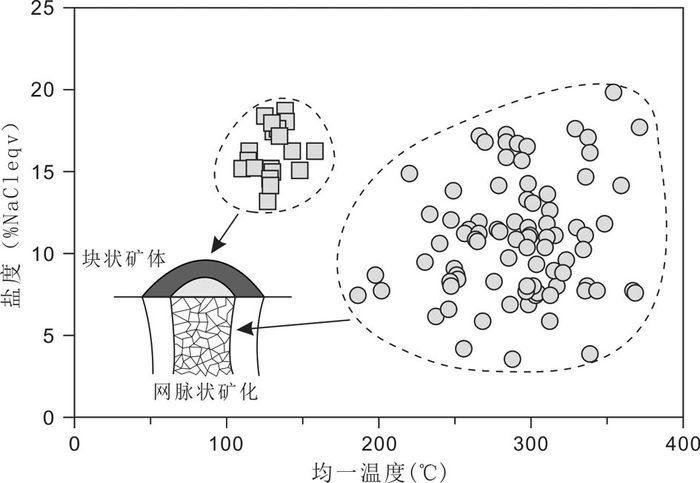
|
图 8 老厂矿床均一温度-盐度协变图 Fig. 8 Covariance figure of fluid inclusions homogenization temperature vs. salinity in Laochang ore deposit |
Marutani and Takenouchi(1978)对Kuroko矿床进行流体包裹体显微测温,结果显示,以脉石矿物石英为寄主矿物的网脉状矿化和块状矿体成矿流体温度分别为280~320℃和260~310℃,而以矿石矿物闪锌矿为寄主矿物的网脉状矿化和块状矿体成矿流体温度分别为235~280℃和200~240℃,总体盐度为2.5%~5.5% NaCleqv。老厂矿床与Kuroko矿床相比,网脉状矿化成矿流体温度相似,但块状矿体成矿流体温度相对较低,同时具有高盐度特征。与OIB火山岩有关的Windy Craggy Cu-Co-Au矿床的成矿温度为140~370℃,盐度为9%~17% NaCleqv(Peter and Scott, 1993),与老厂矿床成矿流体较为相似,反映与OIB火山作用相关的VMS型矿床具有较接近的成矿流体性质。
徐楚明和欧阳成甫(1991)对老厂VMS矿床成矿期中石英和方解石进行了氢氧同位素组成研究,其中石英的δ18OSMOW为9.21‰~9.41‰,δDSMOW为-92‰,方解石的δ18OSMOW为4.1‰,δDSMOW为-93‰,与初始岩浆水的H-O同位素值较为相似(δ18OSMOW=5.5‰~9‰,δDSMOW=-85‰~-40‰) (Sheppard et al., 1971),说明老厂矿床成矿热液有岩浆成因。除此之外,老厂矿床成矿期中方解石碳同位素(δ13C=-7.2‰~-3.1‰)与岩浆碳相似(龙汉生等,2009),也证明了成矿流体具有岩浆成因(Ohmoto, 1972)。
综上所述,本文认为老厂矿床成矿流体是岩浆热液和海水的混合流体,其中下部网脉状矿化以岩浆热液为主,向上海水比例逐渐增大;上部块状矿体流体为岩浆热液沿喷流通道喷出海底并与海水混合,导致温度较低,但盐度变化不大,可能由于成矿前海底已经存在较高盐度卤水。
5.2 矿石硫来源老厂矿床块状硫化物矿石硫同位素测试结果显示,δ34S范围是-0.69‰~1.32‰,极差为2.01‰,平均值为0.73‰,变化范围较窄,与前人研究结果-2.10‰~5.20‰相近(徐楚明和欧阳成甫,1991;叶庆同等,1992;薛步高,1998;Li et al., 2015)。硫化物δ34S值表现出黄铁矿>闪锌矿>黄铜矿>方铅矿的递减顺序,表明成矿过程中硫同位素基本达到了分馏平衡(图 9a)(张理刚,1985;郑永飞和陈江峰,2000)。同一矿体群的块状矿体、浸染状矿体和网脉状矿化δ34S值相似,且Ⅰ号和Ⅱ号矿体群的δ34S值也基本一致(图 9b),说明在老厂矿床多次VMS成矿作用中有稳定的、单一的硫同位素来源。
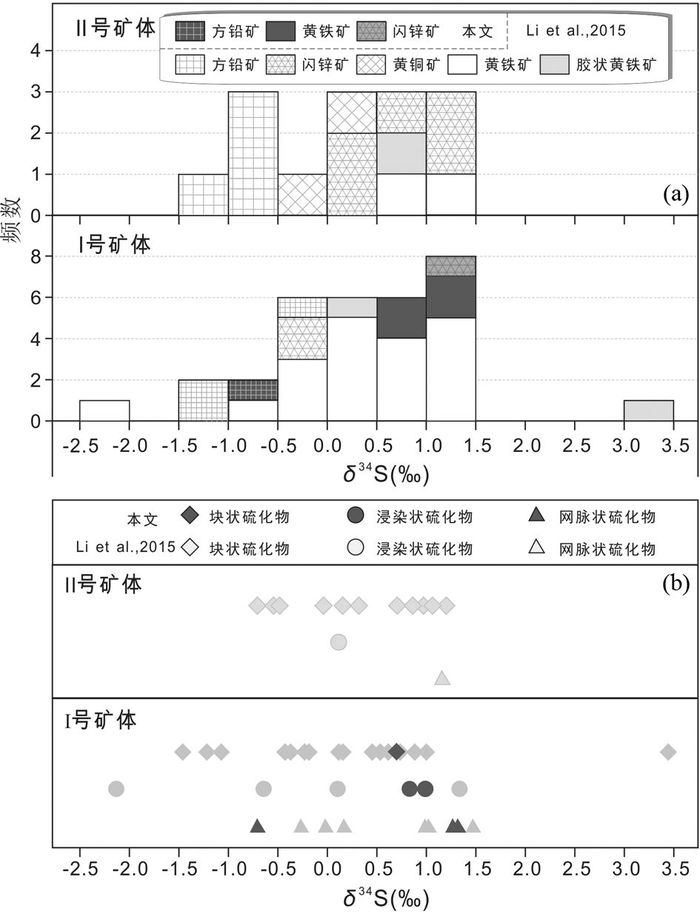
|
图 9 老厂矿床硫同位素分布图 (a)不同硫化物矿物硫同位素柱状图;(b)不同构造硫化物矿物硫同位素柱状图 Fig. 9 Distribution diagram of sulfur isotope composition of the sulfide from Laochang ore deposit (a)sulfur isotope composition of the sulfides illustrated by a histogram based on mineral species; (b)sulfur isotope composition of the sulfides illustrated by a histogram based on mineral structures |
研究表明,海相硫酸盐还原成H2S(无机还原或有机还原)与成矿金属元素结合形成硫化物矿物通常具有较大范围的,其取决于成矿期附近海水硫酸盐初始δ34S值以及海水中硫酸盐的还原和补给速率(Taylor and Beaudoin, 2000; Bradshaw et al., 2008)。无机还原通常会使δ34S值明显偏正;而有机还原(细菌)海水硫酸盐通常使硫化物δ34S值比原硫酸盐降低20%~60%,从而表现出明显的负值(Ohmoto and Goldhaber, 1997)。老厂矿床形成于~320Ma(陈觅等,2010;Liu et al., 2015),根据硫元素随时间变化曲线估算出该时期海水硫酸盐δ34S为15‰~19‰,平均值为17‰(Claypool et al., 1980);老厂矿床形成于动荡的海水环境(陈觅等,2011; Li et al., 2015),因此成矿热液中有充分的海水硫酸盐供给。老厂矿床硫化物硫同位素δ34S集中在零值附近,不具有较大范围和明显正负值的特征,可以排除矿石硫由海相硫酸盐无机或有机还原作用形成的可能性。老厂矿床深部花岗斑岩全岩δ34S为3.00‰~10.06‰(赵晓勇等,2012);若花岗斑岩为上部规模巨大的块状硫化物矿石提供硫元素,根据同位素分馏规律,在δ34S≈0大量硫化物形成同时也会产生大量δ34S呈现较高正值的硫化物或者硫酸盐矿物的沉淀,但老厂矿床并未出现这类具明显δ34S正值的硫化物,且硫酸盐矿物至今尚未发现,因此排除深部花岗斑岩为硫源的可能。老厂矿床下伏OIB型中基性火山岩无Nb、Ta亏损(陈觅等,2011; Li et al., 2015),反映其未与陆壳物质发生混染,因此其δ34S值保持地幔来源的零值特征。综上所述,本文认为老厂矿床硫来源于矿体下伏的中基性火山岩,通过浅部岩浆房的岩浆释气作用直接释放(Yang and Scott, 1996)或者循环海水对含矿岩系的淋滤(Verati et al., 1999)。
此外,老厂矿床硫化物矿石铅同位素206Pb/204Pb、207Pb/204Pb和208Pb/204Pb分别为18.486~18.684、15.546~15.712和38.504~39.024(王新利等,2006;Li et al., 2015),容矿玄武质-安山质凝灰岩铅同位素206Pb/204Pb、207Pb/204Pb和208Pb/204Pb分别为18.664~19.227、15.642~15.822和38.904~40.1115(叶庆同等,1992;陈觅等,2011),二者基本一致;而与深部燕山期花岗斑岩铅同位素206Pb/204Pb、207Pb/204Pb和208Pb/204Pb分别为17.988~18.621、15.586~15.663和38.246~38.910存在一定差异(赵晓勇等,2012)。说明老厂矿床矿石铅也具有下伏中基性火山岩来源特征,和硫的来源相同。
5.3 成矿环境和成矿过程昌宁-孟连古特提斯主洋在早石炭世(~320Ma)持续向两侧扩张,并形成一系列具有OIB地球化学性质的火山岩及有关VMS型矿床,包括老厂矿床。
老厂矿床金属均以硫化物的形式存在,缺乏硫酸盐矿物(重晶石和石膏等)和铁的氧化物矿物,说明在成矿过程中老厂矿床处于一个还原环境(Peter and Goodfellow, 1996; Piercey et al., 2008)。在老厂块状硫化物矿体顶部存在着代表喷流沉积作用结束的纹层状硅质岩(喷气岩),该层含有丰富的碳和大量铁的硫化物(杨开辉和莫宣学,1993a),反映其形成于还原条件(Ohmoto, 1986)。在矿物学方面,老厂矿床闪锌矿富铁(14.3mol%~17.1mol% FeS),属于铁闪锌矿(叶霖等,2012),暗示了成矿流体具有低的氧逸度(Lepetit et al., 2003)。
目前有两种模型可以用于解释具有纯粹还原矿物组合的VMS型矿床。第一种是海底缺氧事件模型,其硫化物中硫主要系海相硫酸盐无机还原作用而成,因此其硫同位素通常呈现明显的正值(Peter and Goodfellow, 1996; Bradshaw et al., 2008)。第二种是卤水池模型,生物还原作用通常较强烈,因此硫同位素常呈明显的负值。老厂矿床硫化物δ34S值集中在零值,与上述两种模型均有明显差异。因此,本文支持老厂块状矿体还原性矿物组合通过岩浆释气作用形成,与流体包裹体同位素示踪结果一致。
Sato (1972)认为VMS矿床块状矿体与对应的网脉状矿化的分布关系和喷流沉积作用中成矿流体密度与周围海水密度的大小关系密切相关(图 10)。类型Ⅰ中ρ成矿流体>ρ海水,在成矿流体喷出海底面后,由于密度较大而集中在喷口附近,随后硫化物形成并沉积形成块状矿体,因此块状矿体距离网脉状矿化(形成于喷流通道中)距离近且矿石含量大;而类型Ⅲ则相反,ρ成矿流体<ρ海水,成矿流体能漂浮到距离喷口更远的地方,并伴随着火山灰等物质同时沉淀,所以块状矿体距离网脉状矿化更远且其中含有更多的火山碎屑物和大洋沉积物;类型Ⅱ则是一种过渡形式。本文测定老厂矿床块状矿体成矿流体温度为131℃,密度为1.051g/cm3,投点位置在类型Ⅰ区域内。野外现象显示块状矿体基本分布在下部网脉状矿化附近,且块状矿体矿石矿物含量极高,缺乏火山碎屑物和大洋沉积物,与数据投点结论基本符合。
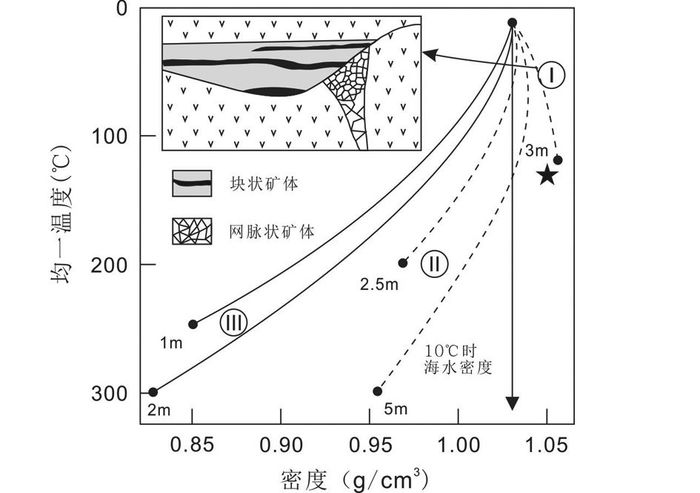
|
图 10 VMS矿床块状矿体分布与成矿流体温度和密度关系图 Fig. 10 Diagram of massive orebody distribution related with metallogenetic fluids temperature vs. density in VMS deposit |
结合本文认识,我们认为老厂矿床具有以下成矿过程:老厂矿床浅部岩浆房中的岩浆通过岩浆释气作用,分离出富含成矿金属元素和硫的岩浆流体;该流体沿喷流通道向上移动,并由于温度和压力下降导致黄铁矿、磁黄铁矿和黄铜矿等硫化物沉淀,即形成网脉状“黄矿”;成矿热液继续向上移动,并喷出海底面与海水发生混合致使温度骤减,导致硫化物沉淀堆积在喷口附近(图 11a),形成纯粹还原矿物组合的块状“黑矿”(方铅矿、闪锌矿等为主)。在此次喷流沉积作用结束后,块状矿体被随后一期火山喷发旋回的火山物质覆盖,形成硫化物矿体-角砾岩-熔岩-凝灰岩-沉积岩的变化规律(图 11b)。
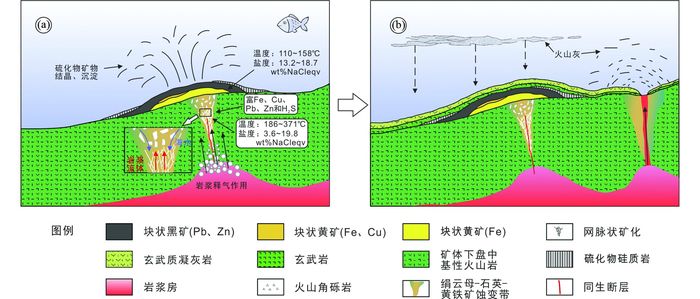
|
图 11 老厂矿床成矿模式图 Fig. 11 Genetic model of the Laochang ore deposit |
(1) 老厂矿床成矿流体为深部成矿热液与海水的混合流体,其中网脉状矿化成矿流体具有中-高温、盐度变化范围大的特征;块状矿体成矿流体具有低温高盐度特征,可能指示了成矿前高盐度卤水的存在;
(2) 矿床硫化物矿石硫同位素集中在零值,共生硫化物对硫同位素基本达到分馏平衡;综合前人C-H-O-Pb同位素分析结果,认为硫主要源于VMS成矿期浅部岩浆房的岩浆释气作用直接释放;
(3) 块状硫化物矿体系由成矿热液沿喷流通道喷出海底面并与海水发生混合降温,导致成矿流体中成矿金属元素以硫化物形式沉淀在喷口附近而形成。
致谢 野外工作得到了云南铅矿有限公司老厂矿山相关人员的大力支持,也感谢一起野外工作的刘金宇博士、于华之博士和高磊硕士;室内工作得到了赵睿博士、崔晓琳博士和李华健博士的帮助; 评审专家审阅论文并提出宝贵修改意见; 特致谢意!| [] | Bodnar RJ. 1993. Revised equation and table for determining the freezing point depression of H2O-NaCl solutions. Geochimica et Cosmochimica Acta, 57(3): 683–684. DOI:10.1016/0016-7037(93)90378-A |
| [] | Bradshaw GD, Rowins SM, Peter JM, Taylor BE. 2008. Genesis of the Wolverine volcanic sediment-hosted massive sulfide deposit, Finlayson Lake District, Yukon, Canada:Mineralogical, mineral chemical, fluid inclusion, and sulfur isotope evidence. Economic Geology, 103(1): 35–60. DOI:10.2113/gsecongeo.103.1.35 |
| [] | Burchfiel BC, Chen ZL. 2013. Tectonics of the southeastern Tibetan Plateau and its adjacent foreland. Memoir of the Geological Society of America, 210: 1–164. DOI:10.1130/9780813712109 |
| [] | Campbell AC, Bowers TS, Measures CI, Falkner KK, Khadem M, Edmond JM. 1988. A time series of vent fluid compositions from 21°N, East Pacific Rise (1979, 1981, 1985), and the Guaymas basin, Gulf of California (1982, 1985). Journal of Geophysical Research, 93(B5): 4537–4549. DOI:10.1029/JB093iB05p04537 |
| [] | Chen BY. 2002. Study on metallogeny of the Laochang Ag-Pb-Zn-Cu polymetallic ore deposit of Lancang, Yunnan. Ph. D. Dissertation. Changsha:Central South University, 1-123 (in Chinese with English summary) |
| [] | Chen H, Ni P, Wang RC, Wang GG, Zhao KD, Ding JY, Zhao C, Cai YT, Xu YF. 2015. A combined fluid inclusion and S-Pb isotope study of the Neoproterozoic Pingshui volcanogenic massive sulfide Cu-Zn deposit, Southeast China. Ore Geology Reviews, 66: 388–402. DOI:10.1016/j.oregeorev.2014.11.002 |
| [] | Chen M, Huang ZL, Luo TY, Yan ZF, Long HS. 2010. SHRIMP dating and its geological significance of zircon in volcanic from Laochang large silver-lead-zinc deposit in western Yunnan Province, China. Acta Mineralogica Sinica, 30(4): 456–462. |
| [] | Chen M, Huang ZL, Luo TY, Yan ZF, Long HS. 2011. Petrogenesis and tectonic significance of the Laochang basalt in western Yunnan Province, China. Acta Mineralogica Sinica, 31(1): 55–61. DOI:10.1016/j.chnaes.2010.11.009 |
| [] | Claypool GE, Holser WT, Kaplan IR, Sakai H, Zak I. 1980. The age curves of sulfur and oxygen isotopes in marine sulfate and their mutual interpretation. Chemical Geology, 28: 199–260. DOI:10.1016/0009-2541(80)90047-9 |
| [] | Deng J, Yang LQ, Wang CM. 2011. Research advances of superimposed orogenesis and metallogenesis in the Sanjiang Tethys. Acta Petrologica Sinica, 27(9): 2501–2509. |
| [] | Deng J, Wang CM, Li GJ. 2012. Style and process of the superimposed mineralization in the Sanjiang Tethys. Acta Petrologica Sinica, 28(5): 1349–1361. |
| [] | Deng J, Ge LS, Yang LQ. 2013. Tectonic dynamic system and compound orogeny:Additionally discussing the temporal-spatial evolution of Sanjiang orogeny, Southwest China. Acta Petrologica Sinica, 29(4): 1099–1114. |
| [] | Deng J, Wang QF, Li GJ, Li CS, Wang CM. 2014a. Tethys tectonic evolution and its bearing on the distribution of important mineral deposits in the Sanjiang region, SW China. Gondwana Research, 26(2): 419–437. DOI:10.1016/j.gr.2013.08.002 |
| [] | Deng J, Wang QF, Li GJ, Santosh M. 2014b. Cenozoic tectono-magmatic and metallogenic processes in the Sanjiang region, southwestern China. Earth-Science Reviews, 138: 268–299. DOI:10.1016/j.earscirev.2014.05.015 |
| [] | Deng J, Wang CM, Li WC, Yang LQ, Wang QF. 2014. The situation and enlightenment of the research of the tectonic evolution and metallogenesis in the Sanjiang Tethys. Earth Science Frontiers, 21(1): 52–64. |
| [] | Deng J, Wang QF. 2015. Gold mineralization in China:Metallogenic provinces, deposit types and tectonic framework. Gondwana Research, 36: 219–274. |
| [] | Deng J, Wang QF, Li GJ. 2016. Superimposed orogeny and composite metallogenic system:Case study from the Sanjiang Tethyan belt, SW China. Acta Petrologica Sinica, 32(8): 2225–2247. |
| [] | Deng J, Wang QF, Li GJ. 2017. Tectonic evolution, superimposed orogeny, and composite metallogenic system in China. Gondwana Research. |
| [] | Ding L, Zhong DL. 1995. The abnormal of REE and Ce in Changning-Menglian Belt Paleotethys siliceous rocks. Science in China (Series B), 25(1): 93–100. |
| [] | Fang NQ, Niu YL. 2003. Late Palaeozoic ultramafic lavas in Yunnan, SW China, and their geodynamic significance. Journal of Petrology, 44(1): 141–158. DOI:10.1093/petrology/44.1.141 |
| [] | Feng QL, Liu BP. 1993. Stratigraphic investigation of the volcanic rocks in Changning-Menglian Tectonic Belt, southwestern Yunnan, China. Geoscience, 7(4): 402–409. |
| [] | Feng QL. 2002. Stratigraphy of volcanic rocks in the Changning-Menglian Belt in southwestern Yunnan, China. Journal of Asian Earth Sciences, 20(6): 657–664. DOI:10.1016/S1367-9120(02)00006-8 |
| [] | Frankin JM, Sangster DF and Lydon JW. 1981. Volcanic-associated massive sulfide deposits. In:Skinner BJ (ed.). Economic Geology 75th Anniversary Volume. Littleton:Society of Economic Geologists, 485-627 |
| [] | Franklin JM, Gibson HL, Galley AG and Jonasson IR. 2005. Volcanogenic massive sulfide deposits. In:Hedenquist JW, Thompson JFH, Goldfarb RJ and Richards JP (eds.). Economic Geology 100th Anniversary Volume. Littleton:Society of Economic Geologists, 523-560 |
| [] | Galley AG, Hannington MD, Jonasson IR. 2007. Volcanogenic massive sulphide deposits. In:Mineral Deposits of Canada:A Synthesis of Major Deposit Types. St. John's, Newfoundland:Geological Survey of Canada, Mineral Deposits Division Special Publication. Geological Association of Canad, 5: 141–162. |
| [] | Hou ZQ, Zhang QL. 1998. CO2-Hydrocarbon fluids of the Jade hydrothermal field in the Okinawa trough:Fluid inclusion evidence. Sciences in China (Series D), 41(4): 408–415. DOI:10.1007/BF02932693 |
| [] | Hou ZQ, Zaw K, Qu XM, Ye QT, Yu JJ, Xu MJ, Fu DM, Yin XK. 2001. Origin of the Gacun volcanic-hosted massive sulfide deposit in Sichuan, China:Fluid inclusion and oxygen isotope evidence. Economic Geology, 96(7): 1491–1512. |
| [] | Humphris SE, Herzig PM, Miller DJ, Alt JC, Becker K, Brown D, Brügmann G, Chiba H, Fouquet Y, Gemmell JB, Guerin G, Hannington MD, Holm NG, Honnorez JJ, Iturrino GJ, Knott R, Ludwig R, Nakamura K, Petersen S, Reysenbach AL, Rona PA, SMITH S, Sturz AA, Tivey MK, Zhao X. 1995. The internal structure of an active sea-floor massive sulphide deposit. Nature, 377(6551): 713–716. DOI:10.1038/377713a0 |
| [] | Klaus H, Dietrich H, Klaus W. 2007. The Lancang River Zone of southwestern Yunnan, China:A questionable location for the active continental margin of Paleotethys. Journal of Asian Earth Sciences, 30(5-6): 706–720. DOI:10.1016/j.jseaes.2007.04.002 |
| [] | Lai SC, Qin JF, Li XJ, Zang WJ. 2010. Geochemistry of the OIB-type basalt from the Wumulong-Tongchangjie area, Changning-Menglian suture zone:Its petrogenesis and tectonic implications. Earth Science Frontiers, 17(3): 44–52. |
| [] | Large RR. 1992. Australian volcanic-hosted massive sulfide deposits:Features, styles, and genetic models. Economic Geology, 87(3): 471–510. DOI:10.2113/gsecongeo.87.3.471 |
| [] | Lepetit P, Bente K, Doering T, Luckhaus S. 2003. Crystal chemistry of Fe-containing sphalerites. Physics and Chemistry of Minerals, 30(4): 185–191. DOI:10.1007/s00269-003-0306-6 |
| [] | Li F, Lu WJ, Yang YZ, Chen H, Shi ZL, Liu SW, Xin R, Luo SL. 2009. Mineralizing texture and metallogenic model of the Laochang polymetallic deposit in Lancang, Yunnan. Geology and Exploration, 45(5): 516–523. |
| [] | Li GD. 2010. Geological characteristics, ore-controlling factors of the Laochang Ag-Pb-Zn-Cu depositin Lancang, Yunnan and its prospecting targets. Mineral Resources and Geology, 24(1): 59–63. |
| [] | Li GJ, Deng J, Wang QF, Liang K. 2015. Metallogenic model for the Laochang Pb-Zn-Ag-Cu volcanogenic massive sulfide deposit related to a Paleo-Tethys OIB-like volcanic center, SW China. Ore Geology Reviews, 70: 578–594. DOI:10.1016/j.oregeorev.2015.01.012 |
| [] | Li HJ, Tian X. 1995. Fluid inclusion and physical-chemical conditions research of Lancang Pb-Zn-Ag-Cu deposit. Mineral Resources and Geology, 9(2): 107–111. |
| [] | Li L, Duan JR, Li F, Ma Y, Huang DY. 1996. Geologic features and multiperiodic syntopogenic metallogenesis of the Laochang Cu-polymetal deposit in Lancang, Yunnan. Yunnan Geology, 15(3): 246–256. |
| [] | Li PW, Gao R, Cui JW, Guan Y. 2004. Paleomagnetic analysis of eastern Tibet:Implications for the collisional and amalgamation history of the Three Rivers Region, SW China. Journal of Asian Earth Sciences, 24(3): 291–310. DOI:10.1016/j.jseaes.2003.12.003 |
| [] | Liang K. 2014. Geochemical characteristics and metallogenic model study of Lancang VMS Pb-Zn polymetallic deposit, western Yunnan Province. Master Degree Thesis. Beijing:China University of Geosciences, 1-113 (in Chinese with English summary) |
| [] | Liu B, Shen K. 1999. Fluid Inclusion Thermodynamics. Beijing: Geological Publishing House: 87-91. |
| [] | Liu YY, Qi L, Gao JF, Ye L, Huang ZL, Zhou JX. 2015. Re-Os dating of galena and sphalerite from lead-zinc sulfide deposits in Yunnan Province, SW China. Journal of Earth Science, 26(3): 343–351. DOI:10.1007/s12583-015-0539-6 |
| [] | Long HS, Luo TY, Huang ZL, Zhou MZ, Yang Y, Qian ZK. 2009. Carbon and oxygen isotopic geochemistry of Laochang large-sized Ag polymetallic deposit in Lancang, Yunnan Province and its significance. Mineral Deposits, 28(5): 687–695. |
| [] | Long HS, Luo TY, Huang ZL, Zhou MZ, Yang Y, Qian ZK. 2011. Rare earth element and trace element geochemistry of pyrite ores in the Laochang large size silver ploymetallic deposit of Lancang, Yunnan Province, China. Acta Mineralogica Sinica, 31(3): 462–473. |
| [] | Lu HZ, Fan HR, Ni P, Ou GX, Shen K, Zhang WH. 2004. Fluid Inclusions. Beijing: Science Publishing House: 20-369. |
| [] | Luo SL, Li F, Jian RT, Chen H. 2010. Rock chemical characteristics and tectonic background of volcanic rock from Laochang mining area in Lancang, Yunnan. Modern Mining(3): 35–39. |
| [] | Lydon JW. 1984. Volcanogenic massive sulfide deposits, Part Ⅰ:A descriptive model. Geoscience Canada, 11: 195–202. |
| [] | Lydon JW. 1988. Volcanogenic massive sulfide deposits, Part 2. Genetic models. Geoscience Canada, 15: 43–65. |
| [] | Marutani M, Takenouchi S. 1978. Fluid inclusion study of stockwork siliceous orebodies of Kuroko deposits at the Kosaka Mine, Akita, Japan. Mining Geology, 28(151): 349–360. |
| [] | Metcalfe I. 2011. Tectonic framework and Phanerozoic evolution of Sundaland. Gondwana Research, 19(1): 3–21. DOI:10.1016/j.gr.2010.02.016 |
| [] | Ohmoto H. 1972. Systematics of sulfur and carbon isotopes in hydrothermal ore deposits. Economic Geology, 67(5): 551–578. DOI:10.2113/gsecongeo.67.5.551 |
| [] | Ohmoto H, Rye RO. 1974. Hydrogen and oxygen isotopic compositions of fluid inclusions in the Kuroko deposits, Japan. Economic Geology, 69(6): 947–953. DOI:10.2113/gsecongeo.69.6.947 |
| [] | Ohmoto H, Skinner BJ. 1983. The Kuroko and related volcanogenic massive sulfide deposit. Economic Geology, 5: 604. |
| [] | Ohmoto H. 1986. Stable isotope geochemistry of ore deposits. Reviews in Mineralogy and Geochemistry, 16(1): 491–559. |
| [] | Ohmoto H, Goldhaber MB. 1997. Sulfur and carbon isotope. Geochemistry of Hydrothermal Ore Deposits: 517–612. |
| [] | Peter JM, Scott SD. 1993. Fluid inclusion and light stable isotope geochemistry of the Windy Craggy Besshi-Type massive sulfide deposit, Northwestern British Columbia. Resource Geology Special Issue, 17: 229–248. |
| [] | Peter JM, Goodfellow WD. 1996. Mineralogy, bulk and rare earth element geochemistry of massive sulfide-associated hydrothermal sediments of the Brunswick Horizon, Bathurst Mining Camp, New Brunswick. Canadian Journal of Earth Sciences, 133(2): 252–283. |
| [] | Peter JM, Leybourne MI, Scott SD, Gorton MP. 2014. Geochemical constraints on the tectonic setting of basaltic host rocks to the Windy Craggy Cu-Co-Au massive sulphide deposit, northwestern British Columbia. International Geology Review, 56(12): 1484–1503. DOI:10.1080/00206814.2014.947335 |
| [] | Piercey SJ, Peter JM, Mortensen JK. 2008. A special issue devoted to continental margin massive sulfide deposits and their geodynamic environments. Economic Geology, 103(1): 1–4. DOI:10.2113/gsecongeo.103.1.1 |
| [] | Roedder E. 1976. Fluid-inclusion evidence on the genesis of ores in sedimentary and volcanic rocks. Geochemical Studies, 2: 67–110. |
| [] | Roedder E. 1984. Fluid inclusions. Reviews in Mineralogy, 12(1): 1–644. DOI:10.2465/minerj.12.1 |
| [] | Rye RO, Ohmoto H. 1974. Sulfur and carbon isotopes and ore genesis:A review. Economic Geology, 69(6): 826–842. DOI:10.2113/gsecongeo.69.6.826 |
| [] | Sato T. 1972. Behavior of ore froming solutions in sea water. Mining Geology, 22: 31–42. |
| [] | Shen SY, Feng QL, Liu BP, Mo XX. 2002. Study on ocean ridge, ocean island volcanic rocks of Changning-Menglian belt. Geological Science and Technology Information, 21(3): 13–17. |
| [] | Sheppard SM, Nielsen RL, Taylor HP. 1971. Hydrogen and oxygen isotope ratios in minerals from porphyry copper deposits. Economic Geology, 66(4): 515–542. DOI:10.2113/gsecongeo.66.4.515 |
| [] | Shi GR, Archbold NW. 1998. Permian marine biogeography of SE Asia. In:Hall R and Holloway JD (eds.). Biogeography and Geological Evolution of SE Asia. The Netherlands: Backhuys Publishers: 57-72. |
| [] | Sone M, Metcalfe I. 2008. Parallel Tethyan sutures in mainland Southeast Asia:New insights for Palaeo-Tethys closure and implications for the Indosinian orogeny. Comptes Rendus Geoscience, 340(2-3): 166–179. DOI:10.1016/j.crte.2007.09.008 |
| [] | Taylor BE, Beaudoin G. 2000. Sulphur stratigraphy of the Sullivan Pb-Zn-Ag deposit, B. C:Evidence for hydrothermal sulphur, and bacterial and thermochemical sulphate reduction. In:Lydon JW, H y T, Slack JF and Knapp M (eds.). The Sullivan Deposit and Its Geological Environment. St. John's, Newfoundland:Mineral Deposits Division of the Geological Association of Canada, 1: 696–719. |
| [] | Van den Kerkhof AM, Hein UF. 2001. Fluid inclusion petrography. Lithos, 55(1-4): 27–47. DOI:10.1016/S0024-4937(00)00037-2 |
| [] | Verati C, Lancelot J, Hékinian R. 1999. Pb isotope study of black-smokers and basalts from Pito Seamount site (Easter microplate). Chemical Geology, 155(1-2): 45–63. DOI:10.1016/S0009-2541(98)00140-5 |
| [] | Wang QF, Deng J, Li CS, Li GJ, Yu Li and Qiao L. 2014. The boundary between the Simao and Yangtze blocks and their locations in Gondwana and Rodinia:Constraints from detrital and inherited zircons. Gondwana Research, 26(2): 438–448. DOI:10.1016/j.gr.2013.10.002 |
| [] | Wang XL, Pang YC, Huang ML, Sun LX, Li W. 2006. Geology and genesis of Laochang Ag-Cu-Pb-Zn polymetallic ore deposit in Lancang Yunnan Province. Geology and Resources, 15(3): 200–204, 221. |
| [] | Wilkinson JJ. 2001. Fluid inclusions in hydrothermal ore deposits. Lithos, 55(1-4): 229–272. DOI:10.1016/S0024-4937(00)00047-5 |
| [] | Wilson PN, Petersen EU. 1989. Fluid inclusion evidence for fluid mixing in the Oxec cyprus-type copper deposit, Guatemala. Economic Geology, 84(2): 444–449. DOI:10.2113/gsecongeo.84.2.444 |
| [] | Wu HR, Boulter CA, Ke BJ, Stow DAV, Wang ZC. 1995. The Changning-Menglian suture zone:A segment of the major Cathaysian-Gondwana divide in Southeast Asia. Tectonophysics, 242(3-4): 267–280. DOI:10.1016/0040-1951(94)00210-Z |
| [] | Xu CM, Ouyang CF. 1991. A study on the genesis of the Ag-Pb-Zn deposit in Lcaochang, Lancang, Yunnan. Journal of Guilin College of Geology, 11(3): 245–252. |
| [] | Xue BG. 1998. Mineralization characteristics of the Laochang Ag-Pb polymetallic deposit, Lanchang. Mineral Resources and Geology(12): 26–32. |
| [] | Yang KH, Mo XX. 1993a. Main features and genetical type of the Laochang volcanogenic massive sulfide deposit, Yunnan Province. Bulletin of the Chinese Academy of Geological Sciences, 14(1): 79–96. |
| [] | Yang KH, Mo XX. 1993b. Late Paleozoic rifting-related volcanic rocks and tectonic evolution in southwestern Yunnan. Acta Petrologica et Mineralogica, 12(4): 297–311. |
| [] | Yang KH, Scott SD. 1996. Possible contribution of a metal-rich magmatic fluid to a sea-floor hydrothermal system. Nature, 383(6599): 420–423. DOI:10.1038/383420a0 |
| [] | Yang KH, Scott SD. 2002. Magmatic degassing of volatiles and ore metals into a hydrothermal system on the modern sea floor of the eastern Manus back-arc basin, western Pacific. Economic Geology, 97(5): 1079–1100. DOI:10.2113/gsecongeo.97.5.1079 |
| [] | Yang LQ, Deng J, Zhao K, Liu JT. 2011. Tectono-thermochronology and gold mineralization events of orogenic gold deposits in Ailaoshan orogenic belt, Southwest China:Geochronological constraints. Acta Petrologica Sinica, 27(9): 2519–2532. |
| [] | Ye L, Gao W, Yang YL, Liu TG, Peng SS. 2012. Trace elements in sphalerite in Laochang Pb-Zn polymetallic deposit, Lancang, Yunnan Province. Acta Petrologica Sinica, 28(5): 1362–1372. |
| [] | Ye QT, Hu YZ, Yang YQ. 1992. The Regional Geochemistry Setting and Au-Ag-Pb-Zn Mineralization of Sanjiang River Area. Beijing: Geological Publishing House: 1-279. |
| [] | Zhang LG. 1985. Stable Isotope Application in Geological Sciences. Xi'an: Shanxi Science and Technology Press: 1-267. |
| [] | Zhang J, Deng J, Chen HY, Yang LQ, David C, Leonid D, Gong QJ. 2014. LA-ICP-MS trace element analysis of pyrite from the Chang'an gold deposit, Sanjiang region, China:Implication for ore-forming process. Gondwana Research, 26(2): 557–575. DOI:10.1016/j.gr.2013.11.003 |
| [] | Zhao XY, Li F, Yang F. 2012. Isotopic geochemical evidence of the sources of ore-forming materials for the Laochang deep porphyry Mo(Cu) deposit in Lancang, Yunnan. Acta Petrologica et Mineralogica, 31(5): 712–722. |
| [] | Zheng YF, Chen JF. 2000. Stable Isotope Geochemistry. Beijing: Science Press: 1-316. |
| [] | 陈百友. 2002. 云南省澜沧老厂银铅锌铜多金属矿床成矿学研究. 博士学位论文. 长沙: 中南大学, 1-123 |
| [] | 陈觅, 黄智龙, 罗泰义, 严再飞, 龙汉生. 2010. 滇西澜沧老厂大型银铅锌多金属矿床火山岩锆石SHRIMP定年及其地质意义. 矿物学报, 30(4): 456–462. |
| [] | 陈觅, 黄智龙, 罗泰义, 严再飞, 龙汉生. 2011. 滇西澜沧老厂地区玄武岩岩石成因与构造意义. 矿物学报, 31(1): 55–61. |
| [] | 邓军, 杨立强, 王长明. 2011. 三江特提斯复合造山与成矿作用研究进展. 岩石学报, 27(9): 2501–2509. |
| [] | 邓军, 王长明, 李龚健. 2012. 三江特提斯叠加成矿作用样式及过程. 岩石学报, 28(5): 1349–1361. |
| [] | 邓军, 葛良胜, 杨立强. 2013. 构造动力体制与复合造山作用——兼论三江复合造山带时空演化. 岩石学报, 29(4): 1099–1114. |
| [] | 邓军, 王长明, 李文昌, 杨立强, 王庆飞. 2014. 三江特提斯复合造山与成矿作用研究态势及启示. 地学前缘, 21(1): 52–64. |
| [] | 邓军, 王庆飞, 李龚健. 2016. 复合造山和复合成矿系统:三江特提斯例析. 岩石学报, 32(8): 2225–2247. |
| [] | 丁林, 钟大赉. 1995. 滇西昌宁-孟连带古特提斯洋硅质岩稀土元素和铈异常特征. 中国科学(B辑), 25(1): 93–100. |
| [] | 冯庆来, 刘本培. 1993. 滇西南昌宁-孟连构造带火山岩地层学研究. 现代地质, 7(4): 402–409. |
| [] | 赖绍聪, 秦江锋, 李学军, 臧文娟. 2010. 昌宁-孟连缝合带乌木龙-铜厂街洋岛型火山岩地球化学特征及其大地构造意义. 地学前缘, 17(3): 44–52. |
| [] | 李峰, 鲁文举, 杨映忠, 陈珲, 石增龙, 刘世维, 辛荣, 罗思亮. 2009. 云南澜沧老厂多金属矿床矿化结构及成矿模式. 地质与勘探, 45(5): 516–523. |
| [] | 李光斗. 2010. 云南澜沧老厂银铅锌铜矿床地质特征、控矿要素及找矿靶区. 矿产与地质, 24(1): 59–63. |
| [] | 李虎杰, 田煦. 1995. 澜沧铅锌银铜矿床矿物包裹体及成矿物化条件的研究. 矿产与地质, 9(2): 107–111. |
| [] | 李雷, 段嘉瑞, 李峰, 马远, 黄敦义. 1996. 澜沧老厂铜多金属矿床地质特征及多期同位成矿. 云南地质, 15(3): 246–256. |
| [] | 梁坤. 2014. 滇西老厂VMS铅锌多金属矿床地球化学特征及成矿模型研究. 硕士学位论文. 北京: 中国地质大学, 1-113 |
| [] | 刘斌, 沈坤. 1999. 流体包裹体热力学. 北京: 地质出版社: 87-91. |
| [] | 龙汉生, 罗泰义, 黄智龙, 周明忠, 杨勇, 钱志宽. 2009. 云南澜沧老厂大型银多金属矿床碳、氧同位素组成及其意义. 矿床地质, 28(5): 687–695. |
| [] | 龙汉生, 罗泰义, 黄智龙, 周志明, 杨勇, 钱志宽. 2011. 云南澜沧老厂大型银多金属矿床黄铁矿稀土和微量元素地球化学. 矿物学报, 31(3): 462–473. |
| [] | 卢焕章, 范宏瑞, 倪培, 欧光习, 沈昆, 张文淮. 2004. 流体包裹体. 北京: 科学出版社: 20-369. |
| [] | 罗思亮, 李峰, 坚润堂, 陈珲. 2010. 云南澜沧老厂矿区火山岩岩石化学特征及构造背景. 现代矿业(3): 35–39. |
| [] | 沈上越, 冯庆来, 刘本培, 莫宣学. 2002. 昌宁-孟连带洋脊、洋岛型火山岩研究. 地质科技情报, 21(3): 13–17. |
| [] | 王新利, 庞艳春, 黄霂莲, 孙利勋, 李威. 2006. 澜沧老厂银铜铅锌多金属矿床地质特征及成因探讨. 地质与资源, 15(3): 200–204, 221. |
| [] | 徐楚明, 欧阳成甫. 1991. 云南澜沧老厂银铅锌矿床成因研究. 桂林冶金地质学院学报, 11(3): 245–252. |
| [] | 薛步高. 1998. 论澜沧老厂银铅多金属矿床成矿特征. 矿产与地质(12): 26–32. |
| [] | 杨开辉, 莫宣学. 1993a. 云南澜沧老厂火山成因块状铅锌铜硫化物矿床的基本特征及其成因类型. 中国地质科学院院报, 14(1): 79–96. |
| [] | 杨开辉, 莫宣学. 1993b. 滇西南晚古生代火山岩与裂谷作用及区域构造演化. 岩石矿物学杂志, 12(4): 297–311. |
| [] | 杨立强, 邓军, 赵凯, 刘江涛. 2011. 哀牢山造山带金矿成矿时序及其动力学背景探讨. 岩石学报, 27(9): 2519–2532. |
| [] | 叶霖, 高伟, 杨玉龙, 刘铁庚, 彭绍松. 2012. 云南澜沧老厂铅锌多金属矿床闪锌矿微量元素. 岩石学报, 28(5): 1362–1372. |
| [] | 叶庆同, 胡云中, 杨岳清. 1992. 三江地区区域地球化学背景和金银铅锌成矿作用. 北京: 地质出版社: 1-279. |
| [] | 张理刚. 1985. 稳定同位素在地质科学中的应用. 西安: 陕西科学技术出版社: 1-267. |
| [] | 赵晓勇, 李峰, 杨帆. 2012. 云南澜沧老厂深部斑岩钼(铜)矿成矿物质来源的同位素地球化学证据. 岩石矿物学杂志, 31(5): 712–722. |
| [] | 郑永飞, 陈江峰. 2000. 稳定同位素地球化学. 北京: 科学出版社: 1-316. |
 2017, Vol. 33
2017, Vol. 33


